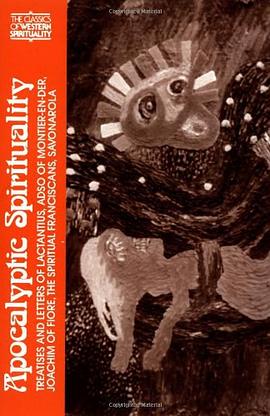
具体描述
A History of the End of the World
Jonathan Kirsch (2006)
The author of Revelation is not the only figure in Christian scriptures whose prediction of the end-times
was mistaken. Jesus, according to some awkward sayings attributed to him in the Gospels, assures his
followers that at least some of them will see the end of the world with their own eyes. The apostle Paul,
in turn, offered the same assurance to his generation of Christians. Both Jesus and Paul were gone by the
time the author of Revelation set down his vision of "things which must shortly come to pass." All of
them turned out to be dead wrong, and the world is still here. The utter, obvious, and persistent failure
of the world to "end on time," as one contemporary Bible scholar wryly puts it, has compelled
Christianity to reconsider how life ought to be lived in the here and now, no less in late antiquity than
today. (13)
The book of Revelation cannot be dismissed as a biblical oddity that belongs only to professional
theologians, media-savvy preachers, and a few religious crackpots. The fact is that Revelation has come
to be regarded by certain men and women in positions of power and influence as a source of inspiration,
if not a divine handbook, for the conduct of war, diplomacy, and statecraft in the real world. When
Ronald Reagan moved into a house whose street number was 666, he insisted on changing the address to a
less satanic number, and he readily interpreted an otherwise unremarkable coup in Libya as the
fulfillment of biblical prophecy:
"That's a sign that the day of Armageddon isn't far off," he declared. "Everything's falling into place.
It can't be long now." (17)
"The day the Temple was destroyed, prophecy was taken from prophets," says the Talmud, "and given to
fools and children." (30)
"Grass will grow in your jawbones, Akiva ben Yosef," one pragmatic rabbi is quoted in the Talmud as
saying to Rabbi Akiva, "and the Messiah will not have appeared." (48)
The poor Greek in which Revelation is written—"John's language," declares one scholar, "is a ghetto
language"—may reveal more about John's white-hot hatred for the Hellenistic civilization of ancient Rome
than it does about his deficiencies in language and learning. Indeed, Adela Yarbro Collins suggests that
John was perfectly capable of writing in proper Greek but chose to intentionally "Semiticize" his work as
"a kind of protest against the higher form of Hellenistic culture" and "an act of cultural pride of a
Jewish Semite." To help the modern reader understand the significance of his choice of language, she
likens it to the use of "Black English" as a badge of honor: "It is analogous to the refusal of some
American blacks to `talk right.'" (64)
John is plainly obsessed with purity in all things, including not only abstract notions of theology but
also such thoroughly human concerns as sex, food, and money. And his obsessive personality may help us
understand why the book of Revelation has always exerted such a powerful influence on readers with
similar traits, ranging from religious zealots to the clinically insane. Indeed, as we shall see, John
provides a proof text for code breakers and conspiracy theorists who, like John himself, are prone to see
the Devil in the unlikeliest of guises. (81)
Now and then, as we shall see, Revelation has roused more than a few men and women to regard themselves
as avenging angels rather than suffering saints, a roster that ranges from Savonarola in the fifteenth
century to David Koresh in the late twentieth century. To his credit, John demands no such thing of his
readers and hearers, and surely he would have been amazed and aghast at what some of them insisted on
making of his work. (91)
Significantly, he does not intend his message to endure for the ages for the simple reason that he is
convinced—and wants to convince his audience—that the end of the world is nigh. . . . Surely the
greatest of all the ironies in John's life and work is the simple and unavoidable fact that the things he
predicts in the book of Revelation did not come to pass quickly or, for that matter, at all. John himself
would have been shocked and heartbroken to know that we are all still here to read what he wrote two
thousand years ago. That is why the book of Revelation and the apocalyptic tradition in Judaism and
Christianity have been called, aptly if also poignantly, "the history of a delusion."
Where in the book of Revelation . . . is the kind and gentle teacher whom Jesus is depicted to be in some
of the most exalted passages of the Gospels? "Love your enemies," says Jesus in the Gospel of Matthew,
"bless them that curse you, do good to them that hate you, and pray for them which spitefully use you,
and persecute you." By contrast, the author of Revelation knows only a violent and vengeful Jesus, "clad
in a robe dipped in blood," armed with a two-edged sword, mounted on a warhorse, and commanding the
"armies of heaven" in a war of extermination against his enemies. (101-2)
Indeed, the single biggest problem with the book of Revelation is the plain fact that the world did not
end. John insists that he has been shown "the things which must shortly come to pass"—and yet, as the
years, decades, and centuries passed, Rome still ruled the world. For those Christians in late antiquity
who regarded the book of Revelation as the revealed word of God, the manifest failure of its prophecies
was embarrassing but undeniable. (109)
Jesus specifically forbids any such speculation—and Augustine admonishes all good Christians who are
inclined to count the years until doomsday to "relax your fingers, and give them a little rest"—but the
plain words of the Gospels and the church fathers have never deterred the mystical number-crunchers.
(126)
One cherished idea about the Apocalypse holds that the hopes and fears for the end of the world spiked in
the year 1000. The turn of the first millennium of the Christian calendar, w are invited to imagine, was
the occasion for extraordinary popular delusions and the madness of crowds, all inspired by the sure
belief that the end was near—"The Terrors of the Year 1000," according to the phrase embraced by a few
overexcited historians. . . . But the idea of a millennial panic in the year 1000, like so much of the
conventional wisdom about the Apocalypse, is wrong.
To be sure, more than a few medieval preachers thrilled at the notion that a thousand years had passed
since the birth of Jesus of Nazareth, and they were convinced that something remarkable would surely
happen. But they did not even agree among themselves whether the momentous year would be 1000, the
anniversary of the birth of Jesus, or 1033, the anniversary of the crucifixion of Jesus, or somewhere in
between. Indeed, the whole exercise of counting down the end of the world in units of one thousand years
was (and is) fundamentally flawed by an error in the calculations of Dionysius Exiguus, the sixth-century
monk who devised the calendar system that uses the markers B.C. ("Before Christ") and A.D. ("Anno
Domini," or "In the Year of Our Lord"). Dionysius, according to modern scholarship, "got the year of
Christ's birth wrong by at least four and possibly as much as six years." As a result, the end of the
first millennium had probably passed unnoticed a few years before the calendar year 1000. (137-8)
Abbo of Fleury, in fact, is the only contemporary observer who links the year 1000 to the end-time
prophecies in the Bible—and he "does so only to dismiss the notion." (138)
"The hands that touch the body and blood of Christ must not have touched the genitals of a whore,"
stormed one preacher in 1059, referring not to prostitutes but to the consecrated wives of the clergy.
But the call for chastity was not purely a spiritual concern; it also served the material and political
interests of the church. A bishop with a wife and children, for example, might be inclined to regard the
lands, buildings, and treasures of his diocese as property to be passed down to his sons. Clearly, the
wealth and power of the church were at risk unless the clergy were deprived of the temptation and
opportunity to sire potential heirs. Such concerns were on the mind of Pope Gregory VII (1020-1085) when
he complained of clerical marriage as a "foul plague of carnal contagion" that "[loosened] the reins of
lust." (140)
Protestant preachers, in fact, were even more readily convinced than their Catholic counterparts that
they knew when the world would end—and, of course, they were just as wrong. Michael Stifel, a German
mathematician, mounted the pulpit in Luther's church to announce his calculation that the end-times would
begin promptly at 8:0 AM on October 19, 133. More than two hundred years alter, undiscouraged by any of
the earlier failed prophecies, an English preacher named George Bell declared with equal certainty that
Jesus Christ would descend from heaven to earth on February 28, 1763. On the night of the promised Second
Coming, John Wesley, the founder of Methodism, preached all night long in an effort to calm the agitated
crowds and prepare them for the disappointment of what he correctly presumed would be the dawning of yet
another unremarkable day. (162)
The Holy Land remained under Islamic sovereignty, but Columbus was encouraged by what he had read in the
apocalyptic texts to see a role for himself in achieving what the crusaders had repeatedly failed to
accomplish—the defeat of the Muslim overlords of Jerusalem. Indeed, he was convinced that God bestowed
the gold and silver of the Americas on Christendom in order to finance the reconstruction of the Temple
in Jerusalem. (170)
Isaac Newton (1642-1727), who achieved enduring greatness in mathematics and physics, also found time to
engage in his own apocalyptic number crunching: "Sir Isaac Newton wrote his comment upon the Revelation,"
cracks French philosopher Voltaire (1694-1778), "to console mankind for the great superiority he had over
them in other respects." (176)
The apocalyptic idea, as we have seen, is supposedly linked to oppression and persecution. The victims,
we are told, console themselves with visions of revenge like the ones that are described so rousingly in
the pages of Revelation. The fact is, however, that the text is capable of stirring up the passions of
ordinary men and women who suffer from nothing more than overactive imaginations. (183)
It was only in the late nineteenth century—principally in America—that the idea of the Rapture was
elevated into an article of faith among Christian fundamentalists. Indeed, the whole idea has been
credited to an Anglo-Irish preacher named John Nelson Darby (1800-1882). . . . Some scholars trace
various elements of Darby's new apocalyptic doctrine back to sources ranging from Joachim of Fiore to
Increase Mather, and Darby has even been accused of stealing the whole idea of the Rapture from a young
woman named Margaret McDonald, a fifteen-year-old Scottish religious ecstatic. Darby himself insisted
that "the doctrine virtually jumped out of the pages of Scripture." Whatever the ultimate source of his
inspiration, however, the fact remains that Darby was an authentic innovator who managed to find a
credulous and enthusiastic audience in the New World. Darby is yet another one of those freelance
preachers and self-appointed prophets who populate the history of the apocalyptic tradition. (191)
Among those who propagated Darby's teaching throughout America was a preacher named Dwight L. Moody
(1837-1899), who has been described as "the evangelist who did more than anyone else in America to spread
premillennial views of an imminent end." . . . The other crucial American convert to Darby's reading of
Revelation was Cyrus R. Scofield (1843-1921), a veteran of the Confederate army who spent some time in
jail on charges of forgery before experiencing a religious conversion and undertaking his life's work of
explaining the prophetic meanings that he found in the Bible. The so-called Scofield Reference Bible, an
edition of the King Jame Version to which Scofield added his own marginal annotations, was first
published in 1909 and ultimately sold more than 10 million copies before it was revised and republished
later in the century. So influential was Scofield, observes Paul Boyer, that many evangelical Christians
"had difficulty remembering precisely where they had acquired a particular idea: from the sacred text
itself, or from Scofield's notes.
Between Moody and Scofield, in fact, the newfangled idea of the Rapture and the various other theological
innovations of John Nelson Darby achieved the status of received truth in the early years of the
twentieth century: "My hope is built on nothing less," went one parody of a gospel song, "than Scofield's
notes and Moody Press." (192)
By a fateful coincidence, the divine plan for the Jewish people in Darby's scenario of the end-time
coincided with the emergence of modern political Zionism in the mid-nineteenth century. (196)
One earnest missionary found out for himself why it was unwise to start canvassing a Jewish tenement from
the ground up. By the time he reached the top floor, the apartment dwellers on the lower floors had read
the literature he was handing out and greeted him on the way back down with curses and insults, hot soup,
and rotten vegetables. "Thus I learned that the next time I went into a tenement house," the young man
explained, "I must start at the top floor and work down." (200)
In the opening years of the twentieth century, "more than three hundred separate denominational bodies,"
according to Paul Boyer, "all committed to belief in Christ's premillennial return. (203)
Tragically, some of the same Christian fundamentalists who saw the creation of a Jewish state in
Palestine as a precondition to the Second Coming were also capable of extraordinary callousness toward
the Jewish victims of the Holocaust. "God may be permitting Satan to use a Hitler, Goebels [sic] or a
Stalin to chasten His People and thus make them discontent in their wealth and prosperity," argued one
Christian tract when the machinery of the Holocaust was already in full operation. "The Jew is gradually
being forced to go back to his promised land. He is not wanted in very many lands." (208)
The "millenarian roots of Nazism" can be discerned in Norman Cohn's masterful study of apocalyptic
violence in the Middle Ages, The Pursuit of the Millennium. Cohn looked all the way back to such
apocalyptic excesses as the mass murder of Jews during the First Crusade—but he was provoked into
undertaking his work when, as an intelligence officer in World War II, he was called upon to interrogate
captured SS men and thereby found himself face-to-face with "a mind-set `in which one can actually feel
it is a good thing to shove small children into ovens or to send millions of people to starve and freeze
to death.'" (209)
Youngsters in fundamentalist homes were reared from early childhood in constant and urgent anticipation
of the end of the world. "Many who were raised as premillennialists can tell horror stories," explains
Timothy P. Weber, "about coming home to empty houses or finding themselves suddenly alone in department
stores or supermarkets and instinctively concluding that Jesus had come and left them behind." (217)
"We may have another year, maybe two years to work for Jesus Christ," warned Billy Graham during his 1950
crusade, "and [then] ladies and gentlemen, I believe it is all going to be over." (218-19)
M. R. DeHaan, the author of a 1963 apocalyptic novel titled The Days of Noah, attributed the moral decay
of America to "women leaving their homes and children to enter factories and shops and offices" and
described "people going almost completely crazy under [the] spell" of popular music: "Squeaks and squawks
and empty groans and baby talking and monkey moans." (219-20)
[Pat Robertson] was already on record as predicting that the end was near—"I guarantee you by the fall
of 1982 there is going to be a judgment on the world," he wrote in 1980. (232)
When Disney World hosted a privately sponsored weekend gathering called "Gay Days," [Pat Robertson]
insisted that the toleration of homosexuality in America will result in hurricanes, earthquakes,
tornadoes, and "possibly a meteor," citing chapter and verse from Revelation to support his prediction.
(232)
What's puzzling goes far beyond the superficial irony of Christians befriending Jews even though they
believe that their Jewish friends have already damned themselves to hell by refusing to embrace Jesus of
Nazareth as the Messiah. That's the same grievance, of course, that prompts the author of Revelation to
refer to his Jewish acquaintances as "the synagogue of Satan." But the end-time scenario that motivates
Christian Zionists to support Israel in the political arena also instructs them that the Jewish state
will ultimately ally itself with the Antichrist—but only until the Antichrist goes to war against his
allies and "slaughter[s] two-thirds of all Jews in a Holocaust worse than anything unleashed by Hitler."
Only the remnant of Jews who convert to Christianity in the last days will be spared, they believe, and
the rest will burn forever in the lake of fire along with Satan himself. (237-8)
Still, at least some Jewish observers are willing to comment on the strange bedfellowship of
fundamentalist Christians and Jews. "This is a grim comedy of mutual condescension," Leon Wieseltier,
literary editor of the New Republic, told the New York Times. "The evangelical Christians condescend to
the Jews by offering their support before they convert or kill them. And the conservative Jews condescend
to Christians by accepting their support while believing that their eschatology is nonsense. This is a
fine example of the political exploitation of religion." (238)
The book of Revelation, as we have seen, insists that humankind has always been confronted with a simple
choice—good or evil, the Lamb or the Beast, God or Satan, and the wrong choice is punishable not merely
by death but by eternal damnation. Like other expressions of religious true belief, which looks on the
remarkable diversity of human faith and practice and declares all but on as error, sin, and crime, the
apocalyptic idea may be hardwired into the human imagination. But the long, strange, and ultimately
tragic history of the book of Revelation—the history of a delusion—proves that it is always a cruel
idea and sometimes a deadly one. (251)
作者简介
目录信息
读后感
评分
评分
评分
评分
用户评价
相关图书
本站所有内容均为互联网搜索引擎提供的公开搜索信息,本站不存储任何数据与内容,任何内容与数据均与本站无关,如有需要请联系相关搜索引擎包括但不限于百度,google,bing,sogou 等
© 2026 qciss.net All Rights Reserved. 小哈图书下载中心 版权所有



















![瑜伽论研究译文集[上、下二册] pdf epub mobi 电子书 下载](https://doubookpic.tinynews.org/3ce57f41062a68376044613e582c873048d8ca4535dd4b8887aad999888e1a1d/s29962263.jpg)

